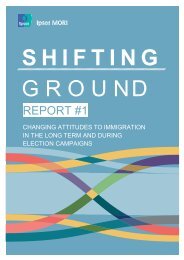You also want an ePaper? Increase the reach of your titles
YUMPU automatically turns print PDFs into web optimized ePapers that Google loves.
clear <strong>that</strong> we are fighting a new battle in an old war? It is the same struggle against the same<br />
enemies. The facts are the same, only the names and faces have changed. 160<br />
Yet discipline and insubordination was never considered too problematic among<br />
the Indian Corps, many of whom would have regarded it as deeply dishonourable<br />
to rebel against direct orders. A legal framework was in place, detailed in the<br />
Manual of Indian Military Law – which was adapted for Indian needs from basic<br />
British military law. 161 It created a raft of potential liabili<strong>ties</strong> including death,<br />
imprisonment, flogging, transportation, and dismissal – though actual<br />
punishments tended to be relatively light and issued only sparingly. The full<br />
weight of the military law was, however, invoked when three trans-frontier<br />
Pathan regiments deserted their posts in Mesopotamia following Turkey’s entry<br />
into the war in 1914. 162 These soldiers were not just motivated by German and<br />
Ottoman propaganda calling for rebellion, but were also influenced by letters<br />
from relatives in India encouraging sedition. While these letters were untypical of<br />
the views held by the majority of Indian Muslims, an anonymous letter sent to<br />
Muslims in the 6th Cavalry cautioned, ‘All the Muslims who have died in this war<br />
fighting for the British will spend an eternity in hell. Kill the English whenever<br />
you get a chance and join the enemy. If you do not win in this world, you will at<br />
all events gain in paradise...join the enemy and you will expel the kafir from your<br />
native land. The flag of Islam is ready and will shortly be seen waving’. 163<br />
This kind of appeal was relatively rare, but is significant because it<br />
foreshadowed the kind of Islamist intemperance and <strong>sep</strong>aratism regularly<br />
displayed today. By the end of 1915, government apprehension about the Pathans<br />
had meant it had stopped recruiting them over official fears they could not be<br />
trusted. 164 After all, the Pathans mainly hailed from the North-West Frontier<br />
Province over which the Raj only had tenuous control. The region was then – as<br />
it is now – largely insular and inward looking, with its leaders attaching little<br />
importance to engaging with the government of India. This made the relationship<br />
between the Raj and NWFP Muslims weaker than it was, for example, in the lives<br />
of Muslims from the Punjab.<br />
Yet the nature of Pathan dissent was highly significant. The troops did not<br />
object to fighting Turkish troops and other Muslims because of a politicised<br />
‘ummah consciousness’, but rather they were concerned about the proximity of<br />
the conflict to revered shrines. The majority of those soldiers continued to serve<br />
when moved to different theatres of war away from sensitive areas. Notably, of<br />
those who refused to fight, very few actually crossed over to the other side and<br />
took up arms against Britain.<br />
Indeed, Indian Muslims had displayed more reservations when fighting against<br />
the Afghans than when they were asked to confront Ottoman troops – whose<br />
ostensible aim was to defend the Caliphate. They often shared a common ethnicity<br />
and history with the Afghans. Indeed, support in India for the Afghan Amir was<br />
arguably higher than it was for the Turkish Sultan-Caliph. During the Second<br />
Afghan War of 1878-80, even Lord Roberts recalled <strong>that</strong> ‘the Mohammedan<br />
element in my force gave me considerable anxiety’. 165 This strain on their loyal<strong>ties</strong><br />
had been so severe <strong>that</strong> the government refused to use them during the<br />
subsequent Frontier expedition of 1897-98. Similarly, when the Afghan Amir was<br />
drawn into a minor skirmish with British troops in May 1919, nearly 1200<br />
Muslims in the World Wars<br />
160 ‘A message to the people of<br />
Pakistan by Ayman Zawahiri’ (As-<br />
Sahab Media, downloaded from<br />
restricted al-Qaeda forum –<br />
Ansarnet). Also see,<br />
http://terrorism.foreignpolicyblog<br />
s.com/2008/08/30/al-qaedassecond-in-command-speaks-out-o<br />
n-pakistan/<br />
161 British Army: Manual of<br />
Military Law 1914,<br />
L/MIL/17/1/2<strong>11</strong>0, IOR, BL,<br />
London<br />
162 Nominal rolls of Indian<br />
prisoners of war suspected of<br />
having deserted to the enemy or<br />
of having given information to, or<br />
otherwise assisted the enemy<br />
after capture, L/MIL/17/5/2403,<br />
IOR, BL, London<br />
163 Anonymous letter to the<br />
Risaldar-Major of the 6th Cavalry,<br />
March 1916 (279) in David<br />
Omissi, Indian voices of the Great<br />
War: soldiers' letters, 1914-18<br />
(New York, 1999)<br />
164 Ibid, p.121<br />
165 Omissi, Sepoy and the Raj,<br />
p.129<br />
policyexchange.org.uk | 39



